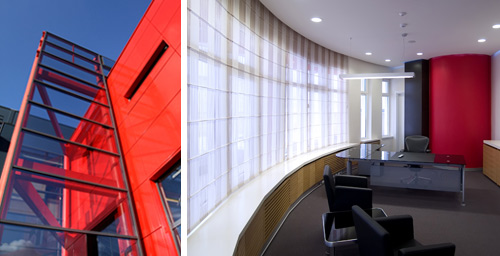Color in the Built Environment: Past, Present, and Future
Current Color Psychology and Symbolism
So here we find ourselves in 2010 at a new point in history influenced by all that has transpired before, the current events of our time, and an eye toward the emergent future. As desingers, we may be aware of the basic color groups to pick from, but as participants in the current times, we know there are more choices than ever before in variations, hues, and combinations of those colors. In the world of design, we might assume basic psychological associations and symbolisms, but what about the general public? If that is who we are serving, then how do we know the associations we are making are current, appropriate, and desirable for the spaces we are creating? Color specialists and professionals in this field have researched these questions and their work is directly relevant to design decisions related to color. Summarized below is some of their commonly accepted current thinking related to the standard "warm" colors of red, orange, yellow, and the warm neutrals of brown and beige along with "cool" colors of green, blue, violet and the cool neutrals of grey, charcoals, as well as black and white. Each of these colors is presented based on current, generalized, U.S. cultural psychological connections and symbolisms along with some alternative international cultural connections. In this context, applications of each color group to selected building types are also indicated.
Warm Colors
In general, the four color groups below are interpreted as warm or hot, coming from the longer wavelengths of the light spectrum and typically create the feeling of advancing toward us.
Energetic red. Think of red roses, red lips, red flags, or red dresses. In the U.S., this is the color of love, desire, passion, excitement, strength, anger, aggression, energy, stimulation and courage. Symbolically, red creates vitality, demands results, encourages achievement, enhances activity, increases pulse rate, nurtures passion, promotes alertness, prompts action, stimulates excitement, and suggests a warm environment.
 |
The energetic color red in settings such as workplaces Photo: Used under license from Shutterstock.com |
Â
Red is viewed somewhat differently in various cultures, including the following:
- China: sex, love, and joy
- England: aristocracy
- United States: Christmas and Valentine's color, danger
Colors from this area of the palette include pink, rose, magenta, cranberry, maroon, burgundy, wine, mauve, ruby and crimson. These colors are best suited for active environments such as athletic and sport facilities, cosmetic areas, restaurant facilities, energetic atmospheres, factory and industrial areas, fast food environments, office areas, passageways and corridors, and physical therapy areas. It is also the industrial safety color for fire protection.









